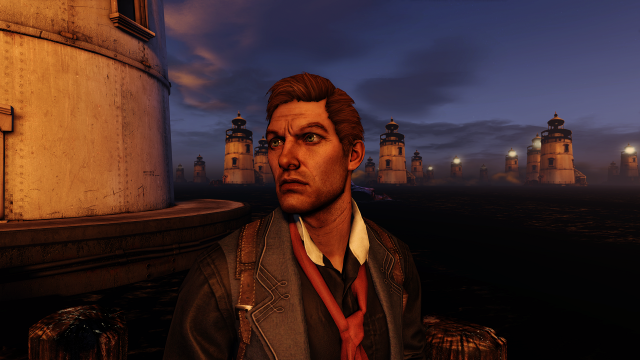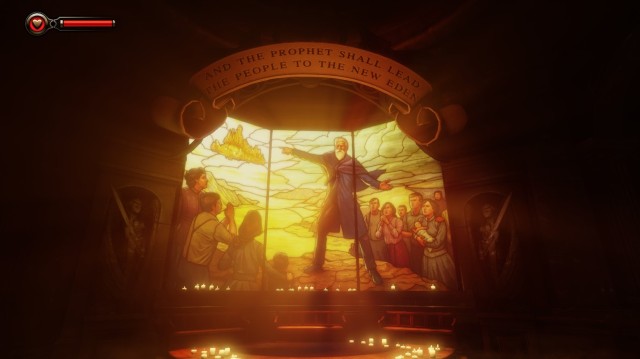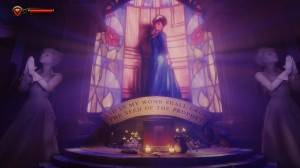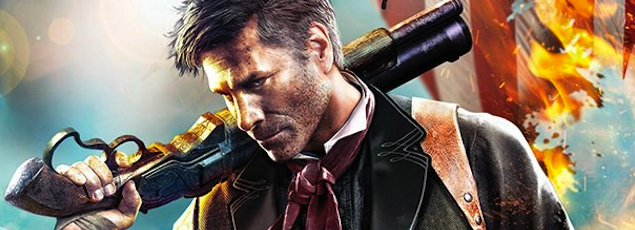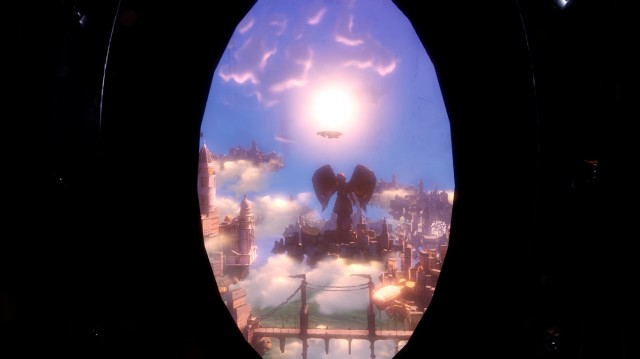*SPOILER WARNING* Everything in this blog contains spoilers for Bioshock: Infinite. Do not read this blog until you have completed the game.
*SPOILER*
*SPOILER*
*SPOILER*
“Where we went wrong was getting on a boat. We can move, of course, change direction, rattle about, but our movement is contained within a larger one that carries us along as inexorably as the wind and current…” – Rosencrantz and Guildenstem are Dead by Tom Stoppard
The two main characters in Tom Stoppard’s 1964 play Rosencrantz and Guildenstem are Dead begin their journey with a bet between each other over the results of coin flips. Each time a coin comes up heads, Rosencrantz gets to keep the coin. The coin lands on heads every single time, 92 times in a row. Rosencrantz is quite pleased, but Guildenstem is bewildered. Such results defy his understanding of probability. In the absence of chance, do they still have free will? Thus begins the two men’s struggle to understand the life they’ve found themselves in.
There are direct parallels between Rosencrantz and Guildenstem and the Robert and Rosalind Lutece in Bioshock: Infinite. While Rosencrantz and Guildenstem find themselves in an immutable universe where their lives are bound by the structure of William Shakespeare’s play, the Luteces have are in a universe of their own inadvertant design which they are attempting to modify. And the Luteces are very unsuccessful until we pick up the controller.
When I was a girl, I dreamt of standing in a room looking at a girl who was, and was not myself, who stood looking at another girl, who also was, and was not myself. My mother took this for a nightmare. I saw it as the beginning of my career in physics. –Rosalind Lutece, August the 10th, 1890
Rosalind Lutece existed in Zachary Hale Comstock’s universe as a brilliant quantum physicist. She authored the book Barriers to Trans-Dimensional Travel in 1889 and it was around that time that she met Comstock. It was through Comstock that Rosalind was able to continue her research as he provided her both finance and opportunity. In return Rosalind helped Comstock build the flying city of Columbia in time for the 1893 Chicago World’s Fair.
I had trapped the atom in mid-air. Colleagues called my Lutece Field quantum levitation, but in fact it was nothing of the sort. Magicians levitate–my atom simply failed to fall. If an atom could be suspended indefinitely, well–why not an apple? If an apple, why not a city? –Rosalind Lutece, August the 10th, 1890
In the early 1890s, Rosalind discovered a single atom that existed between two parallel universes. It was named the Lutece Particle and paved the way for the creation of the Lutece Field, a window into another universe. But Rosalind discovered something even more important on the other side of her atom…
The Lutece Field entangled my quantum atom with waves of light, allowing for safe measurement. Sound familiar, brother? That’s because you were measuring precisely the same atom from a neighboring world. We used the universe as a telegraph. Switching the field on or off became dots and dashes. Dreadfully slow–but now, you and I could whisper through the wall. –Rosalind Lutece, October the 15th, 1893
Robert Lutece existed in Booker DeWitt’s universe and his brilliant career as quantum physicist was equal to that of Rosalind. In fact, with the exception of a single chromosome, Robert and Rosalind were exactly the same. And at the exact same time Rosalind discovered the Lutece particle, so did Robert. It was through this single atom that the two Luteces were able to communicate using morse code. In time the two were able to perfect the Lutece Field machine to allow communication between each other’s universe.
Comstock was thrilled by this development for he believed it would allow him to see into the future. This became the source of his prophecies. The Archangel of Columbia was in fact Rosalind Lutece’s machine. But what Comstock didn’t understand was that he was merely seeing the possible future by glimpsing future events in a parallel universe. What he say as certainty was merely a vision of the “probably.”
Brother, what Comstock failed to understand is that our contraption is a window not into prophecy, but probability. But, his money means the Lutece Field could become the Lutece Tear: a window between worlds. A window through which you and I might finally be together. –Rosalind Lutece, October the 15th, 1893
In order for the future Comstock has seen to come true he will need an heir. “The seed of the prophet shall sit the throne, and drown in flame the mountains of man” is meaningless otherwise. But the Luteces machine has had an unintended side effect on Comstock. His continual usage of it has led to a rapid physical deterioration and sterility. He will never be able to father a child. At least not in his universe…
Comstock seems to have been made sterile by simple exposure to our contraption. A theory: just as sexual reproduction can de-emphasize the traits of each parent, so goes the effect of multiple realities on our own. Your traits dissipate, until they become unrecognizable, or, cease to exist. –Rosalind Lutece, July the 3rd, 1893
Comstock has observed enough of Booker DeWitt’s universe to know that he has a child. Working with Rosalind they formulate a plan to obtain Booker’s daughter and bring her into Comstock’s universe as his own. Genetically she represents his only chance at carrying on his legacy. Robert, because he exists in Booker’s universe, is tasked with offering Booker a deal. Bring us the girl and wipe away the debt. If Booker gives up his daughter, Anna, then the debt who owes to some very bad men will be paid off.
And the plan works almost flawlessly. Not only was Rosalind able to open a tear for the very first time, but Booker agrees to the deal. Robert takes Anna, meets Comstock in an alley and jump through the tear back into Comstock’s universe where Rosalind is waiting. But there is a tiny little mistake. As the tear is closing, the tip of Anna’s pinkie finger on her outstretched hand is severed. This is painful for the baby and a huge metaphysical headache for the multiverse.
Robert’s transition into Rosalind’s universe was not an easy one. He experience confusion and general cognitive dissonance because that which should not be now is. This is the first observable manifestation of the condition Rosalind theorized in her book Barriers to Trans-Dimensional Travel. In it she wrote “The mind of the subject will desperately struggle to create memories where none exist.” Robert goes through a form of this, later so does Booker and once Elizabeth starts opening tears everwhere so do many Columbian citizens.
You have been transfused, brother, into a new reality, but your body rejects the cognitive dissonance through confusion and hemorrhage. But we are together, and I will mend you. For what separates us now, but a single chromosome? –Rosalind Lutece, October the 15th, 1893
It doesn’t take long before Anna, renamed Elizabeth, begins to manifest the ability to open tears. As she ages her power grows. By the time is she is 5 years old they see her first large spike in power which probably led to the creation of the siphon and her imprisonment in the tower. Elizabeth did not need the machine the Luteces used to open tears. She was able to do it herself. This was caused when the tip of her pinkie finger was severed. For a brief moment before the tip of her finger died, she existed in two universes at the same time.
What makes the girl different? I suspect it has less to do with what she is, and rather more with what she is not. A small part of her remains from where she came. It would seem the universe does not like its peas mixed with its porridge. –Rosalind Lutece, September the 5th, 1909
Neither Robert nor Rosalind truly understood the ramifications of what they had done. To them this was all about research and scientific achievement. As long as Comstock got what he wanted he would continue to provide them near unlimited resources to continue their work. And while buying babies is generally looked down on in polite society, when you compare the drunk gambler Booker DeWitt with the wealthy leader of men Comstock you can certainly convince yourself that Anna would be better off with Comstock. Even when it requires a lot of willful naivety on the Luteces part.
So Elizabeth became another part of the Luteces research. She was monitored and studied for the nearly 20 years. To Robert and Rosalind she represented a scientific marvel as the first truly inter-dimensional being. But once they realized what would become of Elizabeth and how she would carry on Comstock’s legacy, things changed.
Our contraption shows us the girl is the flame that shall ignite the world. My brother says we must undo what we have done. But time is more an ocean than a river. Why try to bring in a tide that will only again go out? –Rosalind Lutece, September the 3rd, 1909
Robert wants to set things right, to undo what he has done. Elizabeth must be returned to Booker. Rosalind sees as a futile exercise. She may regret what was done, may want to fix it, but she doesn’t believe they can change anything. What has happened, happened and what will happen, will happen.
My brother has presented me with an ultimatum: if we do not send the girl back from where we brought her, he and I must part. Where he sees an empty page, I see King Lear. But he is my brother, so I shall play my part, knowing it shall all end in tears. –Rosalind Lutece, October the 16th, 1909
Now Rosalind has no choice. Robert is probably the only person in the world capable of standing as her intellectual equal and I’m sure she truly feels affection for him as her brother. He has become her companion for many, many years. To lose Robert would be to lose the other side of herself, to lose the other side of her particular coin.
So a plan is put into motion to restore Elizabeth to her own universe. All you have to do is open a tear, take Elizabeth and toss her in it. Should be easy enough… But at some point Comstock learns of their intentions and is not very pleased. He orders Jeremiah Fink to kill the Luteces and make it look like an accident. So he sabotages their machine to presumably make it explode. And it does.
Comstock has sabotaged our contraption. Yet, we are not dead. A theory: we are scattered amongst the possibility space. But my brother and I are together, and so, I am content. He is not. The business with the girl lies unresolved…but perhaps there is one who can finish it in our stead. –Rosalind Lutece, November the 1st, 1909
Robert and Rosalind are now one with possibility space. They can freely traverse across universes, but they have lost much of their ability to physically manipulate events as they once could. Their plan to restore Elizabeth to her universe and prevent Comstock’s “prophecy” has become much more complicated. But now that they can see across all parallel universes they understand that it always has been more complicated. Only “fixing” one Elizabeth in one universe would do very little to change anything. It is akin to dumping a pile of rocks on your carpet then cleaning it by only picking up one pebble.
The Luteces now turn to Booker and Elizabeth as their pawns in, as Rosalind describes it, their thought experiment. And their perspective has changed significantly. They are no longer bound by time and space. They have all the time in the world to correct their mistake because time is no longer relevant. So they continue their research through observation and data collection like the good scientists that they are. They know what their desired result is, but don’t seem to know how exactly to get there.
During the game they appear and disappear with equal parts whimsy and mystique. With this being the 123rd time they’ve run their experiment we have to assume they’ve tried a multitude of different approaches with Booker and Elizabeth. By now they should know their subjects inside and out. So what they are doing is creating a framework of subtle hints and slight nudges to keep their daddy/daughter team moving forward. Each iteration of the experiment would see slight adjustments being made until ultimately they succeed.
There is a telling scene in the game towards the end when Booker and Elizabeth encounter the Luteces playing the piano. They are attempting to play the Songbird song and we rush down to stop them. But they manage to play the correct notes and nothing happens. They turn to Booker and Elizabeth and explain that while the notes were correct, the instrument was not. At a base level this is how they inform Booker and Elizabeth about the whistle they’ll need to obtain in order to control the Songbird. But at a higher level it speaks to the experiment itself.
Every iteration of the experiment is defined by constants and variables. The constants are unchangeable. The coin will always come up heads, Booker will always get #77, Booker doesn’t row, etc. But the variables of the experiment, the notes of the experiment, are the elements that can be changed. In the Luteces case, the instrument is correct so finding the right notes is their challenge.
Related articles
- Seriously, Booker don’t row! (bioshockmysteries.com)
- Who is that guy? (bioshockmysteries.com)
- The Observer Effect (bioshockmysteries.com)

